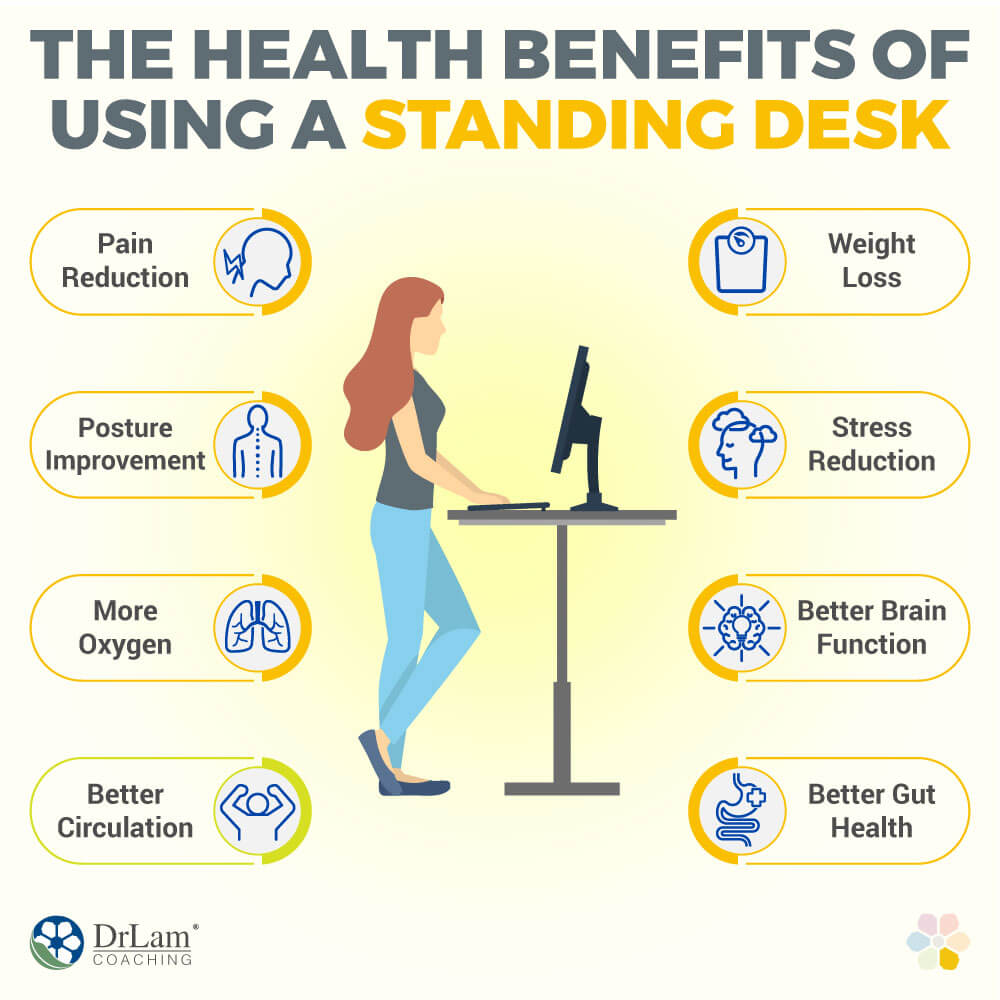Are you considering joining the growing number of people who have made the switch to a standing desk? As more and more research highlights the potential health risks of prolonged sitting, it’s no surprise that standing desks have surged in popularity in recent years.
But simply owning a standing desk isn’t enough – proper setup is key to reaping the full benefits and avoiding discomfort or strain. In this comprehensive guide, we’ll walk you through everything you need to know to set up your standing desk for optimal comfort and efficiency.
Choosing the Right Standing Desk
The first step to setting up a comfortable and efficient workspace is selecting the right standing desk. With so many options on the market, it’s important to consider the following factors:
- Adjustability: Look for a desk with a wide height range to accommodate your individual needs. Pneumatic or electric adjustment mechanisms tend to be the most user-friendly.
- Size: Ensure the desk offers ample space for your monitor, keyboard, mouse, and any other essential work items. Consider your office space and opt for a compact model if needed.
- Stability: A wobbly desk can be frustrating and distracting. Choose a model with a sturdy base and solid construction to minimize movement.
- Features: Some standing desks come with built-in features like cable management systems, USB ports, or even memory presets for your preferred heights. Decide which extras matter most to you.
To help narrow down your options, here are a few of our top standing desk recommendations:
| Desk | Adjustability | Size | Features | Price |
|---|---|---|---|---|
| Jarvis Bamboo Standing Desk | Electric, 25.5″ – 51″ range | 48″ x 30″, 60″ x 30″, 72″ x 30″ | Memory presets, cable management tray | $$$$ |
| Uplift V2 Standing Desk | Electric, 25.5″ – 51.1″ range | 42″ x 30″ up to 80″ x 30″ | Memory keypad, 48 accessory mounting points | $$$$ |
| Flexispot EC1 Standing Desk | Electric, 28″ – 47.6″ range | 48″ x 30″, 55″ x 28″ | Basic up/down keypad, no-frills design | $$$ |
| Vari Electric Standing Desk | Electric, 25″ – 50.5″ range | 48″ x 30″, 60″ x 30″ | LED memory keypad, sturdy T-style legs | $$$ |
Prices: $ = under $200, $$ = $200-$500, $$$ = $500-$1000, $$$$ = over $1000
Proper Posture and Ergonomics
Once you have your standing desk, it’s time to focus on setting it up with proper ergonomics in mind. Maintaining good posture is crucial to minimizing strain and discomfort when using a standing desk.
Follow these steps to ensure an ergonomic setup:
- Adjust desk height: Start by setting your desk at about elbow height. Your elbows should be bent at around a 90-degree angle when typing.
- Position your monitor: The top of your screen should be at or slightly below eye level and about an arm’s length away. Tilt the monitor up slightly to avoid neck strain.
- Align your keyboard and mouse: Place your keyboard and mouse directly in front of you, with your wrists straight and your upper arms close to your body. Consider using an ergonomic keyboard to minimize wrist strain.
- Use an anti-fatigue mat: Standing on a cushioned surface can help reduce pressure on your feet and legs. Look for a mat with a contoured design to encourage subtle movement.
- Wear supportive shoes: Opt for shoes with good arch support and cushioning. Avoid high heels or flip-flops, which can cause discomfort over time.
Here’s a visual guide to help you achieve the ideal ergonomic setup:

Alternating Between Sitting and Standing
While a standing desk offers numerous benefits, it’s not advisable to stand all day long. The key is to alternate between sitting and standing throughout the day to keep your body moving and prevent fatigue.
Here’s a sample schedule you can follow:
- 8:00 AM – 9:30 AM: Stand
- 9:30 AM – 11:00 AM: Sit
- 11:00 AM – 12:30 PM: Stand
- 12:30 PM – 1:30 PM: Lunch break
- 1:30 PM – 3:00 PM: Sit
- 3:00 PM – 4:30 PM: Stand
- 4:30 PM – 5:00 PM: Sit
Of course, you can adjust this schedule based on your personal preferences and work requirements. The goal is to stand for at least 30-60 minutes per hour, gradually increasing your standing time as you build endurance.
Stretches and Exercises for Standing Desk Users
Incorporating regular stretches and exercises into your workday can help alleviate muscle tension and promote better posture. Here are a few simple moves you can do right at your standing desk:
- Neck rolls: Gently roll your head from side to side, holding each position for 5-10 seconds. Repeat 5 times.
- Shoulder shrugs: Lift your shoulders up towards your ears, hold for 5 seconds, then release. Repeat 10 times.
- Calf raises: Stand with your feet hip-width apart and slowly rise up onto your toes. Hold for 5 seconds, then lower back down. Repeat 10-15 times.
- Desk push-ups: Place your hands on the edge of your desk, slightly wider than shoulder-width apart. Lower your chest towards the desk, keeping your core tight. Push back up to the starting position. Repeat 10-15 times.
- Standing hip flexor stretch: Step one foot forward and lower into a slight lunge, keeping your back straight. Hold for 30 seconds, then switch sides.
Remember to listen to your body and stop any exercises that cause pain or discomfort. Aim to take a brief stretching break at least once per hour to keep your muscles loose and limber.
Common Mistakes to Avoid
Even with the best intentions, many standing desk users fall into common pitfalls that can lead to discomfort or even injury. Watch out for these issues:
- Setting the desk too high or low: An improperly adjusted desk can cause strain on your neck, shoulders, or wrists. Make sure to set your desk at the correct height for your body.
- Staying in one position for too long: Avoid standing or sitting in the same position for extended periods. Shift your weight, move around, and alternate positions frequently.
- Hunching or slouching: Poor posture can lead to back, neck, and shoulder pain over time. Make a conscious effort to stand up straight with your shoulders back and down.
- Ignoring signs of discomfort: If you experience pain or discomfort while using your standing desk, don’t try to push through it. Take a break, stretch, and reassess your setup.
By being mindful of these common mistakes and taking steps to correct them, you can ensure a more comfortable and productive experience with your standing desk.
Conclusion
Setting up your standing desk properly is essential to enjoying the many benefits it can offer – from reduced sedentary time to improved posture and increased energy levels. By selecting the right desk, optimizing your ergonomic setup, alternating between sitting and standing, and incorporating regular stretches and exercises, you’ll be well on your way to a healthier and more efficient workday.
Remember, the transition to a standing desk takes time and patience. Start slowly, listen to your body, and make adjustments as needed. With a little practice and persistence, you’ll soon find your ideal balance and rhythm.
So, are you ready to take your workspace to the next level? Implement these tips and enjoy the perks of a properly set-up standing desk – your body (and productivity) will thank you!
The ideal height for your standing desk is where your elbows are at a 90-degree angle when your hands are on the keyboard, ensuring a comfortable typing position and reducing strain on your wrists and arms.
You should aim to alternate between sitting and standing every 30 to 60 minutes to balance comfort and energy without affecting productivity. This ratio helps to minimize the risks associated with prolonged sitting or standing.
Stand with your feet shoulder-width apart, knees slightly bent, and maintain a neutral spine alignment. Your monitor should be at eye level and about an arm’s length away to prevent neck and eye strain.
Yes, standing desks can improve productivity by boosting blood flow and energy levels. They also encourage movement, which can lead to increased brain activity and better focus.
Consider using accessories like anti-fatigue mats, adjustable monitor stands, or keyboard trays to enhance comfort. These can help maintain proper posture and reduce fatigue during long periods of standing.
